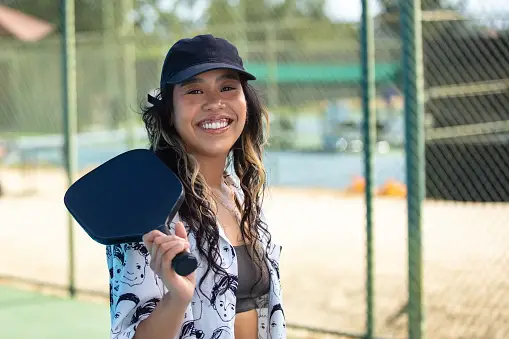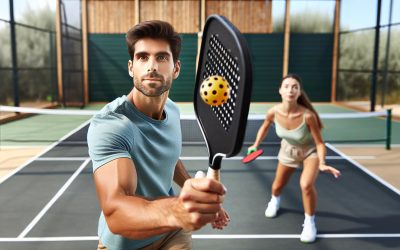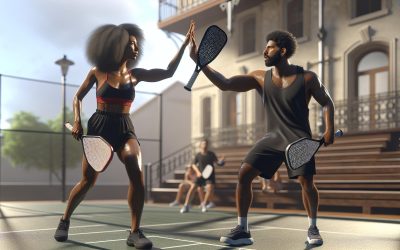Looking to up your pickleball game? I’ve got you covered. Whether you’re a newbie or a seasoned player, there’s always room for improvement. And let’s face it, who doesn’t want to be the one making those winning shots?
Pickleball is a fast-paced, thrilling sport that’s been gaining popularity over the years. It’s a blend of tennis, badminton, and ping-pong, and it’s as fun as it sounds. But, it’s not just about fun. It’s about strategy, agility, and skill too.
So, how can you get better at pickleball? What are the techniques and strategies that can take your game to the next level? I’m here to share some insider tips and tricks that’ll help you become a pickleball pro. Let’s dive in, shall we?
Understanding the Basics of Pickleball
If you’re keen on mastering your pickleball game, getting your basics right is the first step. Learning the fundamental rules, friendly strategies for scoring, and understanding the court dimensions are key to unlocking your pickleball potential.
First and foremost, let’s discuss the court dimensions for the game of pickleball. It’s somewhat similar to a badminton court, and the measurements come in at 20 feet wide by 44 feet long. One major distinguishing feature is the ‘No Volley Zone’ right upfront near the net, also commonly referred to as “the kitchen.” This section spans 7 feet on both sides of the net, and volleying (hitting the ball before it bounces) is strictly prohibited within this zone.
| Pickleball Court Dimensions |
|---|
| Width: 20 feet |
| Length: 44 feet |
| No Volley Zone: 7 feet |
Now let’s dive a bit into scoring strategies. One key thing to remember is that a team only scores a point when serving. The game is played typically up to 11 points, but a team must win by a margin of at least 2 points. Additionally, competitive games can sometimes go up to 15 or even 21 points.
If you’re the serving team and the return ball is hit out of bounds, strikes any part of the non-volley zone on the fly or bounces twice before being returned, you score a point. But make sure you’ve got your serving sequence right. If you serve out of turn or from the wrong position, you’ll end up losing your serve.
Improving Your Grip and Technique
Let’s delve into some details on how to enhance your pickleball game through improved grip and refined technique.
Personalizing Your Grip
Your game largely depends on your grip. It’s like the steering wheel of your play. A weak grip leads to loss of control over the ball, it’s just that simple. Moreover, a poorly positioned grip can result in unnecessary stress and potential injuries to your wrist or elbow.
How do you gain a perfect grip? Experts recommend the “Eastern” pickleball grip. This grip aligns the base of your index finger with the backside of the paddle, offering a perfect blend of control and power. Yet, it’s critical to remember that there’s no one-size-fits-all grip. Make sure to adjust your grip until it feels the most comfortable and efficient for you.
Mastering the Technique
Perfecting the technique in pickleball is just as crucial as having a firm grip. Here’s a tip: Start off with developing a steady serve. Not only do a firm and controlled serves give you the chance to score points, but it also sets the mood for the rest of your play.
Next, you should work on your dinking skills. Dinking is a soft shot that lands in the opponent’s “No Volley Zone,” aiming to keep them off balance. This shot requires a lot of finesse, so it’s vital to practice.
Last, but no less important—the volley. In pickleball, volleying the ball directly out of the air is a smart move, but remember to stay clear of the “No Volley Zone.”
Wrap this all up, and you’re well on your way to optimizing your grip and technique in pickleball. Just remember: Practice is paramount. Theoretical understanding can only take you so far, but regular practice will ensure you improve your game dramatically.
Mastering the Serve
Often overlooked, the serve in pickleball plays a crucial role in setting the tone for your game. Let’s delve into some strategies to develop a potent serve.
Firstly, you’ll want to establish a consistent serving routine. This includes positioning of feet, the grip on your paddle, and ball toss. Consistency breeds predictability and helps establish a rhythm, taking the nervous edge off the game. Position yourself with one foot forward, pointing towards the targeted area of serve. If you’re right-handed, that’ll most likely be your left foot and vice versa.
Next, it’s all about ball placement. You get only one chance to serve in pickleball, so where you place your serve matters. Try to aim for the back third of the court, making it difficult for your opponent to return the ball, especially if they prefer to play at the net.
Subsequently, keep your serve low. A lot of people think power serves are the key. However, pickleball isn’t like tennis, where ace serves often win games. In pickleball, the ball must bounce before the return, hence a lower serve reduces the angles of return, forcing your opponent into a defensive position.
Let’s check out some data related to serving styles in pickleball:
| Serving Styles | % of Players Using This Style |
|---|---|
| Hard and low | 70% |
| Soft and high | 25% |
| Mix of both | 5% |
While working on the serve, always practice against a variety of players. This will help you understand and adapt to a multitude of styles and speeds, significantly diversifying your game.
Remember, mastering your serve is a journey, not a destination. Always be open to learning and, importantly, experimenting with new strategies on your serve. It’s through this continual fine-tuning that you’ll pave your way to becoming a real force on the pickleball court.
Developing Your Footwork and Agility
After mastering the serve and practicing against a diverse range of opponents, the next step in elevating your pickleball game lies in improving your footwork and agility. These two skills are crucial in quickly adapting to various scenarios during gameplay.
Shall we begin with footwork? Effective footwork allows you to move efficiently around the pickleball court. It’s about maintaining balance, controlling spatial positioning, and getting to the ball in the optimal fashion. Practice moving side to side, back and forth – don’t forget those quick short steps required when volleying at the net. The key to an improved footwork lies in the following:
- Wearing appropriate shoes that offer good support
- Regular drills focused on multi-directional movements
- Footwork-based strength and conditioning exercises
As for agility, this is how quickly you can change direction without losing balance or speed. Enhancing your agility lets you return even the most hard-to-reach shots, making you a formidable player on the court. Important factors in enhancing agility include:
- Working on speed drills
- Practicing plyometric exercises
- Regularly playing against unpredictable opponents
A prominent example of agility in action in pickleball is “the dink.” This is a soft shot that’s purposefully aimed at the opposing team’s non-volley zone. The intention here is to force them off-balance, hence the need for excellent agility to execute or counter such a tactic.
You may ask – can agility be improved? Absolutely! Through regular practice and training, you’ll find yourself swiftly moving across the court, returning shots like a pro!
These tips on footwork and agility aren’t just for beginners – seasoned players should continually revisit their footwork and agility regiment. The moment I stop improving, that’s when I start to lose. Let’s always strive to be better, to keep our game fresh, and to keep our opponents guessing on the pickleball court. The journey of pickleball mastery is a constant uphill climb, and there’s always something new to learn and integrate into our game.
Strategies for Smart Game Play
After mastering your serve, fine-tuning your footwork and enhancing your agility, let’s delve into strategies for smart gameplay. Strategy in pickleball isn’t just about hitting the ball. Instead, it’s a mental game that requires planning, focus and the ability to adjust to constantly changing circumstances.
A fantastic place to begin is anticipation. Understanding your opponent’s next move even before they execute it can be key to efficiently counter and strategize your game. To improve anticipation skills, try to observe patterns in your opponent’s play, judge their body language, and anticipate their shots. Noticing things like their setup for a shot can give clues about where they’re likely to hit next.
Your next strategic weapon is positioning. Understanding where to stand on the court can drastically affect the outcome of a match. When playing doubles, it’s usually best to form a ‘stacked’ formation, with both players standing side by side and covering half the court each. This formation helps in covering a wider range of shots and eases the execution of across-the-court shots.
Then comes shot selection. You and your doubles partner want to make shots that are challenging for your opponents—but manageable for you. Opt for calculated, low-risk shots over high-risk power shots. One such smart shot is the ‘third shot drop’. It’s a lob-like shot that sails the ball to drop over the net into the opponents’ non-volley zone. This forces opponents back and buys you extra time and space on your side.
Power isn’t everything, remember the power of the dink shot. No, it’s not a weak soft shot as it’s thought to be. The purpose of the dink isn’t to win the point outright, but to shift your opponents out of position, set them off-balance, approach the net, and create an opportunity for a winning slam.
Implement these strategies, remain consistent in your approach and you’ll find your pickleball game elevating to the next level.
Conclusion
So there you have it. To excel in pickleball, it’s not just about power or speed. It’s about being smart and strategic. Anticipation, positioning, and shot selection are key. Mastering the third shot drop and the dink shot can give you a significant edge. But remember, consistency is king. It’s not enough to know these strategies; you need to apply them in every game. Keep practicing, stay focused, and you’ll see your pickleball skills soar. It’s time to take your game to the next level. Are you ready to become a pickleball pro? Let’s get to it!














0 Comments